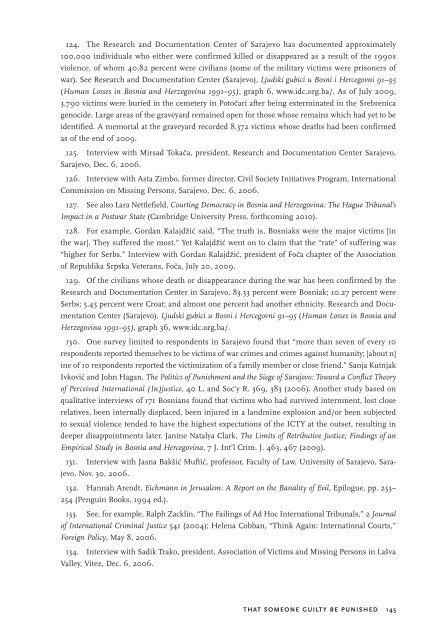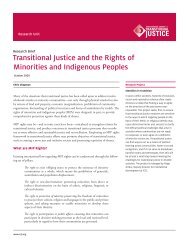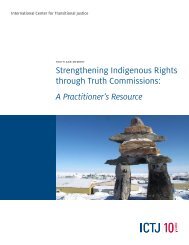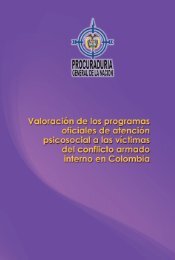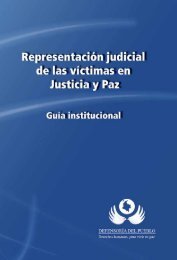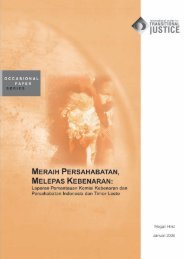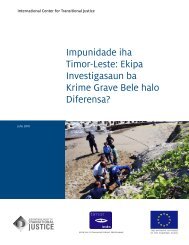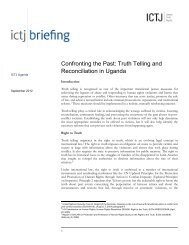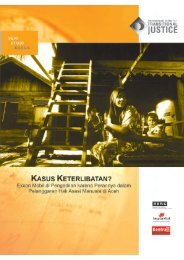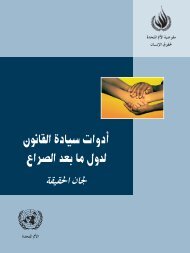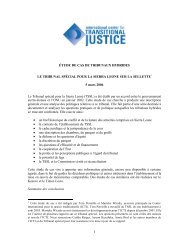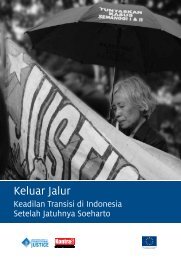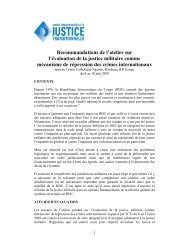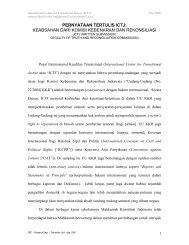That Someone Guilty Be Punished - International Center for ...
That Someone Guilty Be Punished - International Center for ...
That Someone Guilty Be Punished - International Center for ...
Create successful ePaper yourself
Turn your PDF publications into a flip-book with our unique Google optimized e-Paper software.
124. The Research and Documentation <strong>Center</strong> of Sarajevo has documented approximately<br />
100,000 individuals who either were confirmed killed or disappeared as a result of the 1990s<br />
violence, of whom 40.82 percent were civilians (some of the military victims were prisoners of<br />
war). See Research and Documentation <strong>Center</strong> (Sarajevo), Ljudski gubici u Bosni i Hercegovni 91–95<br />
(Human Losses in Bosnia and Herzegovina 1991–95), graph 6, www.idc.org.ba/. As of July 2009,<br />
3,790 victims were buried in the cemetery in Potočari after being exterminated in the Srebrenica<br />
genocide. Large areas of the graveyard remained open <strong>for</strong> those whose remains which had yet to be<br />
identified. A memorial at the graveyard recorded 8,372 victims whose deaths had been confirmed<br />
as of the end of 2009.<br />
125. Interview with Mirsad Tokača, president, Research and Documentation <strong>Center</strong> Sarajevo,<br />
Sarajevo, Dec. 6, 2006.<br />
126. Interview with Asta Zimbo, <strong>for</strong>mer director, Civil Society Initiatives Program, <strong>International</strong><br />
Commission on Missing Persons, Sarajevo, Dec. 6, 2006.<br />
127. See also Lara Nettlefield, Courting Democracy in Bosnia and Herzegovina: The Hague Tribunal’s<br />
Impact in a Postwar State (Cambridge University Press, <strong>for</strong>thcoming 2010).<br />
128. For example, Gordan Kalajdžić said, “The truth is, Bosniaks were the major victims [in<br />
the war]. They suffered the most.” Yet Kalajdžić went on to claim that the “rate” of suffering was<br />
“higher <strong>for</strong> Serbs.” Interview with Gordan Kalajdžić, president of Foča chapter of the Association<br />
of Republika Srpska Veterans, Foča, July 20, 2009.<br />
129. Of the civilians whose death or disappearance during the war has been confirmed by the<br />
Research and Documentation <strong>Center</strong> in Sarajevo, 83.33 percent were Bosniak; 10.27 percent were<br />
Serbs; 5.45 percent were Croat; and almost one percent had another ethnicity. Research and Documentation<br />
<strong>Center</strong> (Sarajevo), Ljudski gubici u Bosni i Hercegovni 91–95 (Human Losses in Bosnia and<br />
Herzegovina 1991–95), graph 36, www.idc.org.ba/.<br />
130. One survey limited to respondents in Sarajevo found that “more than seven of every 10<br />
respondents reported themselves to be victims of war crimes and crimes against humanity; [about n]<br />
ine of 10 respondents reported the victimization of a family member or close friend.” Sanja Kutnjak<br />
Ivković and John Hagan, The Politics of Punishment and the Siege of Sarajevo: Toward a Conflict Theory<br />
of Perceived <strong>International</strong> (In)justice, 40 L. and Soc’y R. 369, 383 (2006). Another study based on<br />
qualitative interviews of 171 Bosnians found that victims who had survived internment, lost close<br />
relatives, been internally displaced, been injured in a landmine explosion and/or been subjected<br />
to sexual violence tended to have the highest expectations of the ICTY at the outset, resulting in<br />
deeper disappointments later. Janine Natalya Clark, The Limits of Retributive Justice; Findings of an<br />
Empirical Study in Bosnia and Hercegovina, 7 J. Int’l Crim. J. 463, 467 (2009).<br />
131. Interview with Jasna Bakšić Muftić, professor, Faculty of Law, University of Sarajevo, Sarajevo,<br />
Nov. 30, 2006.<br />
132. Hannah Arendt, Eichmann in Jerusalem: A Report on the Banality of Evil, Epilogue, pp. 253–<br />
254 (Penguin Books, 1994 ed.).<br />
133. See, <strong>for</strong> example, Ralph Zacklin, “The Failings of Ad Hoc <strong>International</strong> Tribunals,” 2 Journal<br />
of <strong>International</strong> Criminal Justice 541 (2004); Helena Cobban, “Think Again: <strong>International</strong> Courts,”<br />
Foreign Policy, May 8, 2006.<br />
134. Interview with Sadik Trako, president, Association of Victims and Missing Persons in Lašva<br />
Valley, Vitez, Dec. 6, 2006.<br />
THAT SOMEONE GUILTY BE PUNISHED 145


